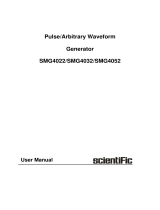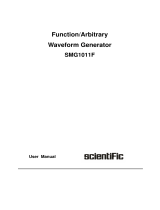
Contents RIGOL
DG1000Z Programming Guide III
Contents
Guaranty and Declaration ......................................................................................................... I
Document Overview ................................................................................................................. II
Chapter 1 Programming Overview...................................................................................... 1-1
To Build Remote Communication ............................................................................................... 1-2
Remote Control Methods ........................................................................................................... 1-4
SCPI Command Overview .......................................................................................................... 1-4
Syntax ............................................................................................................................... 1-4
Symbol Description ............................................................................................................ 1-5
Parameter Type .................................................................................................................. 1-5
Command Abbreviation ...................................................................................................... 1-6
Chapter 2 Command System ............................................................................................... 2-1
:COUNter Commands ................................................................................................................ 2-3
:COUPling Commands ............................................................................................................... 2-9
:DISPlay Commands ............................................................................................................... 2-23
:HCOPy Commands ................................................................................................................. 2-28
IEEE488.2 Common Commands ............................................................................................... 2-29
:LICense Command ................................................................................................................ 2-37
:LXI Commands ...................................................................................................................... 2-38
:MEMory Commands ............................................................................................................... 2-41
:MMEMory Commands ............................................................................................................ 2-46
:OUTPut Commands ............................................................................................................... 2-55
:PA Commands ....................................................................................................................... 2-62
:ROSCillator Commands .......................................................................................................... 2-65
:SOURce Commands ............................................................................................................... 2-67
:SOURce:APPLy Commands .............................................................................................. 2-72
:SOURce:BURSt Commands .............................................................................................. 2-82
:SOURce:FREQuency Commands ...................................................................................... 2-91
:SOURce:FUNCtion Commands ....................................................................................... 2-100
:SOURce:HARMonic Commands ...................................................................................... 2-110
:SOURce:MARKer Commands .......................................................................................... 2-115
:SOURce[:MOD]:AM Commands ...................................................................................... 2-117
:SOURce[:MOD]:ASKey Commands ................................................................................. 2-122
:SOURce[:MOD]:FM Commands ...................................................................................... 2-126
:SOURce[:MOD]:FSKey Commands ................................................................................. 2-131
:SOURce[:MOD]:PM Commands ...................................................................................... 2-136
:SOURce[:MOD]:PSKey Commands ................................................................................. 2-141
:SOURce[:MOD]:PWM Commands ................................................................................... 2-145
:SOURce:MOD Commands .............................................................................................. 2-151
:SOURce:PERiod Command ............................................................................................ 2-153
:SOURce:PHASe Commands ........................................................................................... 2-154
:SOURce:PULSe Commands ............................................................................................ 2-155
:SOURce:SUM Commands .............................................................................................. 2-159
:SOURce:SWEep Commands ........................................................................................... 2-162
:SOURce:TRACe Commands ........................................................................................... 2-172
:SOURce:TRACK Command ............................................................................................. 2-179
:SOURce:VOLTage Comamnds ........................................................................................ 2-180
:SYSTem Commands ............................................................................................................. 2-187
:TRIGger Commands ............................................................................................................ 2-203
Chapter 3 Application Examples ......................................................................................... 3-1
To Output Basic Waveform ........................................................................................................ 3-2
To Output Arbitrary Waveform ................................................................................................... 3-2
To Output Harmonic Waveform .................................................................................................. 3-3

























